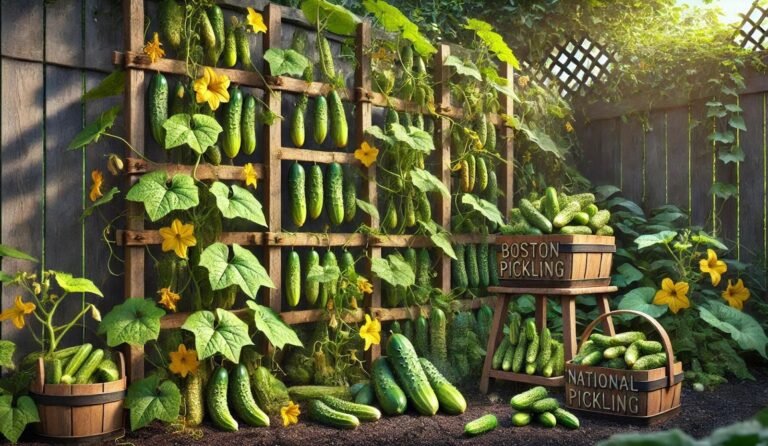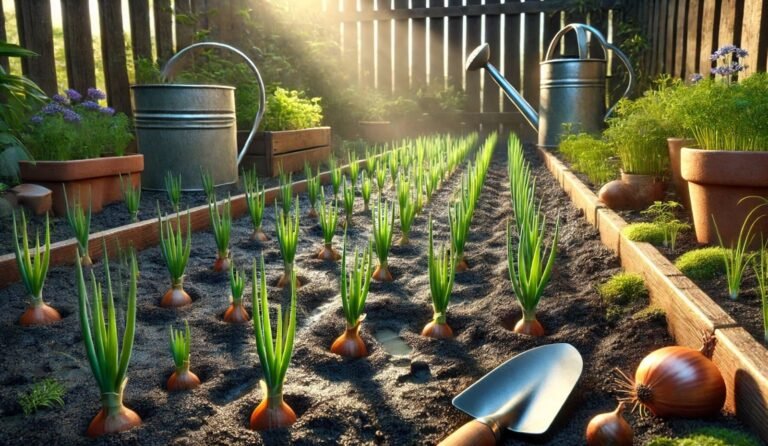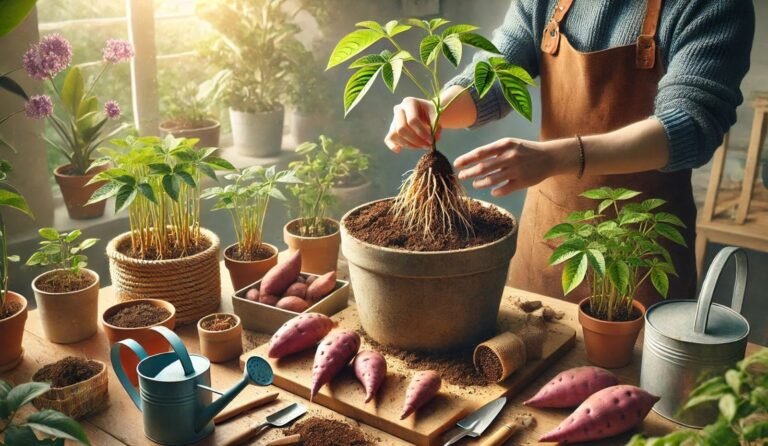Planting Onions in the Fall for Bigger Spring Harvests
Planting onions in the fall might just be your garden’s best-kept secret. While most people are winding down their growing season, you could be getting a serious head start on next year’s harvest. Fall planting gives your onions time to establish strong roots before winter hits, so they can shoot up fast and strong once spring rolls around.
It’s less stressful than spring planting, saves you time when the garden gets busy, and can lead to bigger, better bulbs. Whether you’ve got a backyard plot or a few containers by the window, fall is the perfect time to sneak in one more round of growing. Stick around—we’re diving into everything you need to know to grow awesome onions this autumn.
Why Planting Onions in the Fall Just Makes Sense
Planting onions in the fall isn’t just for show; it’s a gardener’s secret weapon. Unlike more sensitive vegetables, onions are surprisingly cold-hardy. They don’t mind dipping temperatures and even benefit from a dormant period over the winter.
When you plant onions in fall, onions use the remaining warm days to quietly develop strong root systems. Come spring, while other crops are just waking up, your onions are already off to the races—growing faster, stronger, and maturing weeks earlier than spring-planted ones.
But it’s not just about early harvests.Autumn onion planting also helps spread out your garden chores. Spring can get hectic with everything needing to be planted at once. By tackling onions in the fall, you free up valuable space—and time—for your other crops when the warmer months roll around.
Understanding Onion Varieties: Picking the Right Type for Fall
Not all onions are created equal, and choosing the right variety is half the battle. What many new gardeners don’t realize is that onions are photoperiod sensitive. That means their bulb development is triggered by daylight hours—not just temperature.
There are three main types of onions: short-day, intermediate-day, and long-day. If you’re planting in the fall, you’ll want to focus on overwintering varieties, which are usually short-day or specially bred for autumn planting.
Short-day onions begin forming bulbs once daylight reaches 10-12 hours, making them great for southern regions with mild winters. Long-day onions, which need 14-16 hours of daylight to bulb properly, are better suited for northern areas—but they’re usually planted in spring unless you have a very cold-hardy variety.
Some fantastic overwintering onions include ‘Senshyu Yellow’, ‘Tough Ball’, and ‘Radar’. These are specifically designed to handle a cold sleep and wake up thriving when spring returns. If you’re unsure, your local garden center can usually point you toward the best varieties for your zone.
Seeds, Sets, or Transplants: What Should You Use?
Here’s where the choice gets personal. There are three main ways to grow onions—seeds, sets, and transplants—and each comes with its own perks.
Onion seeds are the most affordable and offer the widest range of varieties. However, they take a bit more time and care. You’ll need to start them indoors well in advance (think late summer) to get them big enough to transplant outside in the fall.
Transplants are seedlings that have already been started—either by you or a supplier. They give you a bit of a head start and more control over what you’re planting. But they’re a bit more delicate and may need extra attention to get established before winter hits.
Now, onion sets are arguably the easiest and most fall-friendly option. Plant onion sets in autumn are small, partially grown bulbs that you pop straight into the ground in the fall. They’re hardy, quick to establish, and ideal for beginners. Most gardeners planting in fall prefer sets because they’re simple and reliable. If you’re new to onions, start here—you won’t regret it.
Timing is Everything: When Should You Plant?
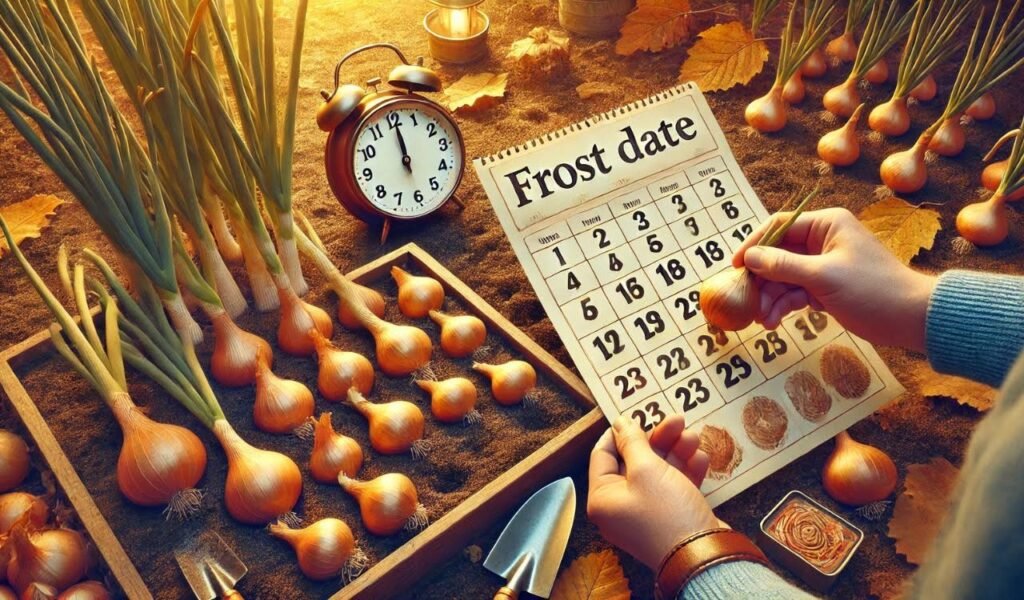
If there’s one rule to remember, it’s this: plant your onions 4 to 6 weeks before your first expected hard frost. That window gives them just enough time to develop roots and maybe a few green shoots before winter really kicks in.
In most temperate regions, this means you’ll be planting from mid-September to mid-October. Of course, that can vary depending on your USDA hardiness zone. In warmer zones (7-10), you can plant a bit later—sometimes into November. If you’re in a colder climate (zones 3-6), it’s best to aim for late September.
Don’t stress too much if you’re a little early or late. Onions are tougher than they look, and as long as they get a few good weeks before the ground freezes, they’ll settle in just fine.
Preparing the Soil (or Pots) for Your Onion Stars
Good soil is everything when it comes to onions. Outdoors, choose a sunny spot that gets at least 6-8 hours of direct sunlight per day. The soil should be loose, well-draining, and rich in organic matter. Onions hate soggy feet, so avoid areas where water tends to pool. If your garden soil is heavy clay, consider adding compost and sand to lighten it up.
Aim for a soil pH between 6.0 and 7.0. A soil test can help you get precise, but a general-purpose vegetable fertilizer or compost usually does the trick if you’re winging it.
If you’re growing indoors, use containers that are at least 6 inches deep. Choose a high-quality potting mix and ensure your pots have good drainage. Place them near a sunny window or under grow lights for at least 10-12 hours a day. Onions grown indoors can still thrive if they get enough light and consistent moisture.
Autumn Planting Onion Sets (No Fuss, No Frills)
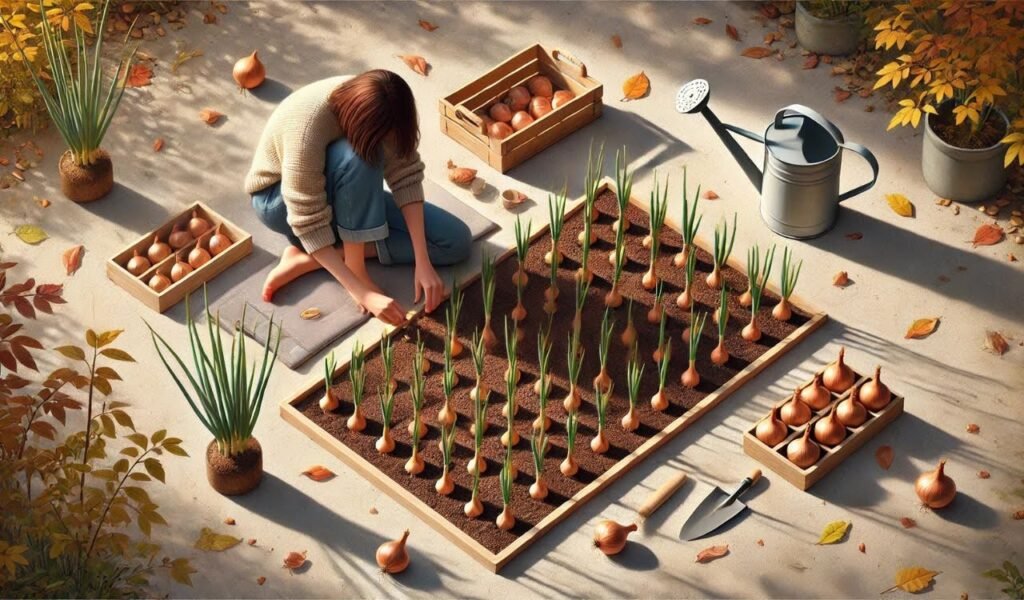
Once your soil is prepped and ready, it’s time to plant. Place your onion sets about 1 to 2 inches deep, making sure the pointy end faces up. Space them 4 to 6 inches apart in rows that are about 12 inches apart. If you’re tight on space or growing in containers, you can go a little closer, but give them room to grow if you want full-size bulbs.
Water them well after planting to settle the soil and kickstart root development. Then, mulch the area with a thick layer of straw, shredded leaves, or grass clippings. This mulch acts like a cozy blanket, keeping the soil temperature steady and protecting your onions from harsh winter swings.
You might not see much action above ground until spring—but trust that underground, your onions are busy building roots and getting ready for their time to shine.
Winter Care: What Happens After Planting?
Once winter rolls in, your job gets easier. Onions go dormant in cold weather, which means you don’t need to water or fertilize much at all. Just make sure your mulch stays in place, especially if you get high winds or snow.
In very cold climates, you might want to cover your onion bed with a row cover or garden fabric to provide a little extra protection. But in most areas, the mulch is enough to see them through.
Keep an eye out during warm winter spells. If the ground thaws and you get a few days of sunshine, your onions might try to start growing again early. That’s usually not a problem—they’ll pause again once it gets cold.
Spring Awakening: Here’s When the Magic Happens
As soon as the weather warms and days get longer, your onions will wake up. It’s a beautiful thing. Those tiny shoots you saw in the fall will shoot up rapidly, and the bulbs will begin to form as the sunlight increases.
At this point, you can remove the mulch or thin it out to allow better airflow. Resume regular watering, and start feeding your onions with a balanced fertilizer or compost tea to support their rapid growth. Keep the bed weed-free, as onions hate competition.
Keep an eye out for bolting (when a flower stalk emerges). It usually happens when the plant experiences stress, like a sudden cold snap or big temperature swing. Once an onion bolts, the bulb stops growing, so harvest and use bolted onions quickly—they’re still edible but won’t store as well.
Harvest Time: When and How to Reap the Rewards
Onions are ready to harvest when the green tops start to yellow and flop over—usually by late spring or early summer, depending on your region. Once most of the tops have fallen, stop watering and give them about a week to dry out a bit in the ground.
Then, gently lift them with a fork or by hand (don’t yank them out!). Lay the onions in a single layer somewhere warm, dry, and out of direct sunlight to cure. A garage, porch, or well-ventilated shed works great.
After 2-3 weeks, when the outer skins are papery and the necks are fully dry, trim the roots and tops. Your onions are now ready for storage! Keep them in a cool, dark place with good airflow, and they’ll last for months.
Common Problems and How to Fix Them
Fall-planted onions are generally low-maintenance, but a few issues might pop up. Bolting, as mentioned, is often caused by stress or cold damage. To minimize this, choose bolt-resistant varieties and avoid planting too early.
Onion maggots and thrips are the main pests to watch for. Crop rotation helps here—don’t plant onions in the same spot two years in a row. Keep the area weed-free and consider adding beneficial insects like ladybugs if pests persist.
Fungal diseases like downy mildew or white rot can occur in overly wet conditions, so make sure your soil drains well and doesn’t overwater.
FAQ
Can onions really be planted in the fall?
Yes! Fall planting allows onions to establish roots and grow faster in spring.
What type of onions should I plant in the fall?
Choose overwintering or short-day varieties suited for your climate zone.
When is the best time for planting onions in the fall?
About 4–6 weeks before your area’s first hard frost.
Do fall-planted onions survive winter?
Absolutely—if properly mulched, they can overwinter and thrive.
Should I use seeds or sets for fall planting?
Sets are easiest for fall; they establish quickly and resist cold better.
Can I grow onions indoors in the fall?
Yes, use containers with good light and drainage for indoor success.
How do I protect onions during winter?
Apply a thick mulch layer and consider row covers in colder zones.
Final Thoughts
Planting onions in the fall is one of those gardening hacks that pays off big time. You get a jumpstart on the growing season, spread out your gardening workload, and enjoy an earlier, often more bountiful harvest.
Whether you’re digging into your backyard or nurturing a few containers on the balcony, fall onions are a smart, satisfying addition to your garden. And once you taste your first home grown onion—planted in the crisp autumn air and harvested before the heat of summer—you’ll never go back to spring-only gardening. So grab some sets, find a sunny spot, and get planting. Your spring self will thank you.



